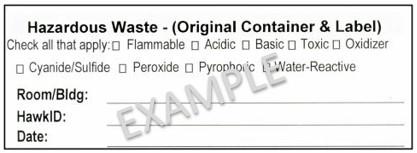To All Generators of Chemical Waste,
This is to inform you of recent changes to hazardous waste labels used on waste chemicals. The changes were necessary to comply with the Environmental Protection Agency’s new Hazardous Waste Generator Improvements Rule and are as follows:
- The department name was eliminated.
- Fill in your HawkID, not your name.
- The date has been re-positioned on the label.
- Added a box to alert EHS staff that an item is ready for pick-up on the large label. Check this box when containers are to be removed by EHS.
- Added check boxes to alert staff to the hazards present in the waste.
These changes took effect May 30, 2017.
Discard old labels and replace with new labels. Apply new labels OVER old labels already applied to containers.
Request the following types of labels using this Label Request Form.
- Hazardous Waste
- Radioactive Waste Tags
- Biohazardous Waste Certifications
- Universal Waste (Batteries, Lamps and Mercury Containing Instruments)
- Used Oil
- Beryllium Warning
Labels are free of charge and will be sent through campus mail.
Small Hazardous Waste Label Information
Small hazardous waste labels are used on materials that are in original containers that still have the original manufacturer’s label.
Request labels from EHS by submitting an online Label Request Form. Complete labels in pencil (not ink pen). Be sure the hazardous waste label does not cover the original label.

Large Hazardous Waste Label Information
Large hazardous waste labels are for commingled wastes, wastes in containers (whether original or not) that are missing the original labels.
Request labels from EHS by submitting an online Label Request Form. Complete labels in pencil. All components of the waste must be listed on the label and must total 100%.

Labeling Procedures
- Only labels provided by EHS are acceptable. Labels may be obtained free of charge by submitting the Label Request Form.
- Each container must have a label. The label must be attached to the container when it is initially used for waste, then when full, add the date.
- Complete labels in pencil. (Pencil is superior to ink pen, due to its resistance to solvent and acid splashes.)
- Labels must contain your HawkID, room number and building.
- Wastes that are commingled must list all components in the contents section, including water and all trace materials. Components must be listed as soon as they are added to the container. Components must total 100%.
- Check the appropriate box(es) for each hazard present in the waste container. To determine hazards refer to reagent container labels and SDS.
- Record the pH of aqueous wastes.
- Commingled waste containers must have all other labels effaced to avoid identity confusion.
- If a container holds only the original contents, the hazardous waste label should be placed so that the original label is not covered. If a container is too small to facilitate this, the label should be placed next to the container for disposal. The label will be applied to an inventory tag that EHS attaches to each bottle.
- Check the “item ready for pick-up” box when the container is ready for removal by EHS.